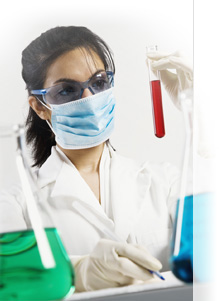Childhood Skin Diseases & Disfigurement
Alopecia Areata
Alopecia areata results in loss of hair on the scalp, eyebrows, and other areas, and it affects over four million people in the U.S. It appears in males and females of all ages, but the onset is usually in childhood.
The condition seems to be a suppression of the hair follicle (cells and tissues that cause the growth of hair), in which the affected area ceases to produce hair. The extent ranges from a few bare patches to loss of hair from the entire body. The hair follicles remain alive and hair may grow back, but further loss may still recur.
The effect of hereditary and environmental factors in alopecia areata is still not understood. Treatments can help, especially in milder cases, but none are universally effective.
For more information, please visiting the following websites:
- http://www.naaf.org/
- http://www.aad.org/public/publications/pamphlets/common_alopecia.html
- http://www.niams.nih.gov/Health_Info/Alopecia_Areata/default.asp
Atopic Dermititis (Eczema)
Atopic dermatitis (known also as "atopic eczema) is a disease characterized by chronic inflammation of the skin. The skin of a patient with atopic dermatitis becomes dry, red, flaky and very itchy.
It most commonly affects the skin on the flexural surfaces of the joints (for example inner sides of elbows and knees) but any body surface can be affected. It also tends to develop skin infections with bacteria that are normal skin inhabitants. The skin of patients with atopic dermatitis may be easily irritated by soaps, environmental allergens and occasionally certain foods that will not present a hazard to normal skin.
Atopic dermatitis often presents with other atopic diseases like hay fever, asthma and conjunctivitis. It is a familial and chronic disease and periods of remissions are possible, even years.
Atopic dermatitis affects approximately 20% of children and 2-3% of adults in industrialized countries, and its prevalence in the United States has increased dramatically in the past forty years. Atopic dermatitis may often be confused with psoriasis, particularly in the older age groups.
Although there is no cure for atopic eczema, and its causes are not yet well understood, it can be treated quite effectively with a combination of prevention measures and drug therapy. These include extensive moisturizers, and topical and systemic anti-inflammatory preparations, that will usually produce a temporary relief in the disease. Dietary changes did not prove as a beneficial strategy for the patients.
More information about the disease and support groups can be found at the following sites:
-
National Eczema Association
4460 Redwood Hwy., Ste. 16-D
San Rafael, CA 94903-1953
415.499.3474 / 800.818.7546
Fax: 415.472.5345
http://www.nationaleczema.org
info@nationaleczema.org
For more information, please visiting the following websites:
- http://www.niams.nih.gov/Health_Info/Atopic_Dermatitis/default.asp
- http://www.aad.org/public/publications/pamphlets/skin_eczema.html
- http://www.nationaleczema.org/lwe/aboutad.html
Epidermolysis Bullosa (EB)
Epidermolysis bullosa (EB) is a group of inherited disorders in which the skin and mucous membranes are so delicate that the lightest touch can cause painful blistering. EB affects an estimated two out of every 100,000 infants, and the casualty rate is high.
Forms of EB range from seasonal irritation of the hands and feet to external and internal blistering over 75 percent of the body. Sores and scar tissue develop, resulting in severe complications that can lead to general debilitation, cancer, and premature death.
For more information, please visiting the following websites:
- http://www.debra.org/
- http://www.niams.nih.gov/Health_Info/Epidermolysis_Bullosa/epidermolysis_bullosa_ff.asp
- http://www.nlm.nih.gov/medlineplus/ency/article/001457.htm
- http://www.ebkids.org/
Hemangioma
Hemangioma are blood vessel tumors that appear as red to blue colored masses in the first four weeks of life, most often in premature babies. These tumors grow alarmingly fast in the first year, and then disappear gradually over the next decade. The rapid growth phase may cause difficulties such as obstruction of vision, and hemangiomas may leave scarring.
For more information, please visiting the following websites:
- http://www.nlm.nih.gov/medlineplus/ency/article/001459.htm
- http://www.medicinenet.com/hepatic_hemangioma/article.htm
Icthyosis
Ichthyosis is a group of genetic disorders of varying severity characterized by dry, thickened, scaling skin. Dermatologists estimate that there are at least 20 varieties - the most common affecting one out of every 250 people - but several forms are quite rare.
Ichthyosis is caused by a genetic defect. In some cases the characteristics are obvious at birth, and in others the symptoms appear during the child's first year.
In all cases, ichthyosis causes a buildup of skin cells in the outer layers of the skin, often accompanied by an inordinate loss of moisture. As the thickened skin dries, it shrinks, cracks, and forms into scales.
The rigidity inhibits movement, and the skin is prone to abrasion, which can lead to infection. In extreme cases, the whole body is covered with broad, dark scales separated by deep cracks.
The physical, medical, and cosmetic manifestations of ichthyosis are most obvious in childhood. The scaling may inhibit growth and motor ability, and the child is prone to ridicule, isolation, and low self esteem.
For more information, please visiting the following websites:




